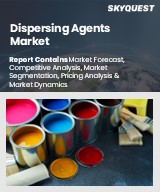
세계의 분산제 시장 규모는 2023년에 76억 달러로 평가되며, 2024년 80억 1,000만 달러에서 2032년에는 122억 달러로 성장하며, 예측 기간(2025-2032년)의 CAGR은 5.4%로 성장할 전망입니다.
세계 분산제 시장은 건설, 페인트, 코팅, 농약 등 주요 산업 수요 증가에 힘입어 강력한 성장세를 보이고 있습니다. 건설 분야에서는 인프라 프로젝트 증가에 힘입어 효과적인 콘크리트 혼합물을 만들기 위해 이러한 약품이 매우 중요합니다. 페인트 및 코팅 분야에서 분산제는 안료의 균일한 혼합을 촉진하고 색상의 일관성과 안정성을 향상시킵니다. 농업 분야에서는 안정적인 비료와 농약 배합을 위해 이러한 약품에 의존하고 있습니다. 그러나 석유화학 시장에 좌우되는 불안정한 원료 가격, 환경문제로 인한 규제 제약, 여러 특성을 겸비한 다기능 첨가제와의 경쟁 등 과제가 산적해 있습니다. 또한 바이오의 지속가능한 의약품을 찾는 움직임은 혁신적이고 용도에 특화된 제제의 필요성을 강조하고 있습니다.
Global Dispersing Agents Market size was valued at USD 7.6 billion in 2023 and is poised to grow from USD 8.01 billion in 2024 to USD 12.2 billion by 2032, growing at a CAGR of 5.4% during the forecast period (2025-2032).
The global dispersing agents market is witnessing robust growth, driven by increasing demand from key industries such as construction, paints, coatings, and agrochemicals. In construction, these agents are crucial for creating effective concrete mixtures, bolstered by rising infrastructure projects. In the paints and coatings sector, dispersing agents facilitate uniform pigment mixing, enhancing color consistency and stability, which is vital for high-performing formulations. The agricultural sector relies on these agents for stable fertilizers and pesticide formulations. However, challenges persist, including volatile raw material prices influenced by petrochemical markets, regulatory constraints due to environmental concerns, and competition from multifunctional additives that combine multiple properties. Additionally, the push for bio-based, sustainable agents highlights the need for innovative, application-specific formulations.
Top-down and bottom-up approaches were used to estimate and validate the size of the Global Dispersing Agents market and to estimate the size of various other dependent submarkets. The research methodology used to estimate the market size includes the following details: The key players in the market were identified through secondary research, and their market shares in the respective regions were determined through primary and secondary research. This entire procedure includes the study of the annual and financial reports of the top market players and extensive interviews for key insights from industry leaders such as CEOs, VPs, directors, and marketing executives. All percentage shares split, and breakdowns were determined using secondary sources and verified through Primary sources. All possible parameters that affect the markets covered in this research study have been accounted for, viewed in extensive detail, verified through primary research, and analyzed to get the final quantitative and qualitative data.
Global Dispersing Agents Market Segments Analysis
Global Dispersing Agents Market is segmented by Form, Structure, End User and region. Based on Form, the market is segmented into Liquid and Powder. Based on Structure, the market is segmented into Anionic, Non-ionic, Cationic and Amphoteric. Based on End User, the market is segmented into Construction, Paints & Coatings, Agrochemicals, Pulp & Paper, Oil & Gas, Textiles and Detergents. Based on region, the market is segmented into North America, Europe, Asia Pacific, Latin America and Middle East & Africa.
Driver of the Global Dispersing Agents Market
The global growth in construction and infrastructure development significantly fuels the demand for dispersing agents. These substances, particularly superplasticizers, are essential for creating durable and workable concrete, making them vital in the construction industry. As urbanization progresses and infrastructure projects proliferate worldwide, the need for these important admixtures continues to rise. This trend underscores the increasing reliance on dispersing agents to enhance concrete performance, reflecting the broader dynamics of a thriving global market that seeks efficient and effective solutions for modern construction challenges.
Restraints in the Global Dispersing Agents Market
The Global Dispersing Agents market faces challenges due to the reliance on petrochemical feedstocks for many dispersing agents. The prices of these raw materials are highly sensitive to the volatility of international oil and gas markets. Such price fluctuations can significantly impact the production costs and profit margins of manufacturers in this sector. As a result, companies may experience increased uncertainty and financial risks, complicating strategic planning and operational stability. This dependency on fluctuating commodity prices can hinder growth and create obstacles for businesses aiming to maintain consistent supply and competitive pricing in the dispersing agents market.
Market Trends of the Global Dispersing Agents Market
The global dispersing agents market is witnessing a notable trend towards bio-based and sustainable solutions as manufacturers adapt to stringent environmental regulations and shifting consumer preferences. This evolution is driven by the rising demand for dispersing agents formulated from renewable resources like lignin and starch, which offer enhanced biodegradability and a lower carbon footprint. As businesses prioritize eco-friendly practices, the integration of these green alternatives not only fulfills regulatory requirements but also aligns with the growing consumer awareness around sustainability. Consequently, the market is expected to increasingly favor products that embody these environmental objectives, shaping future innovations and competitive strategies.